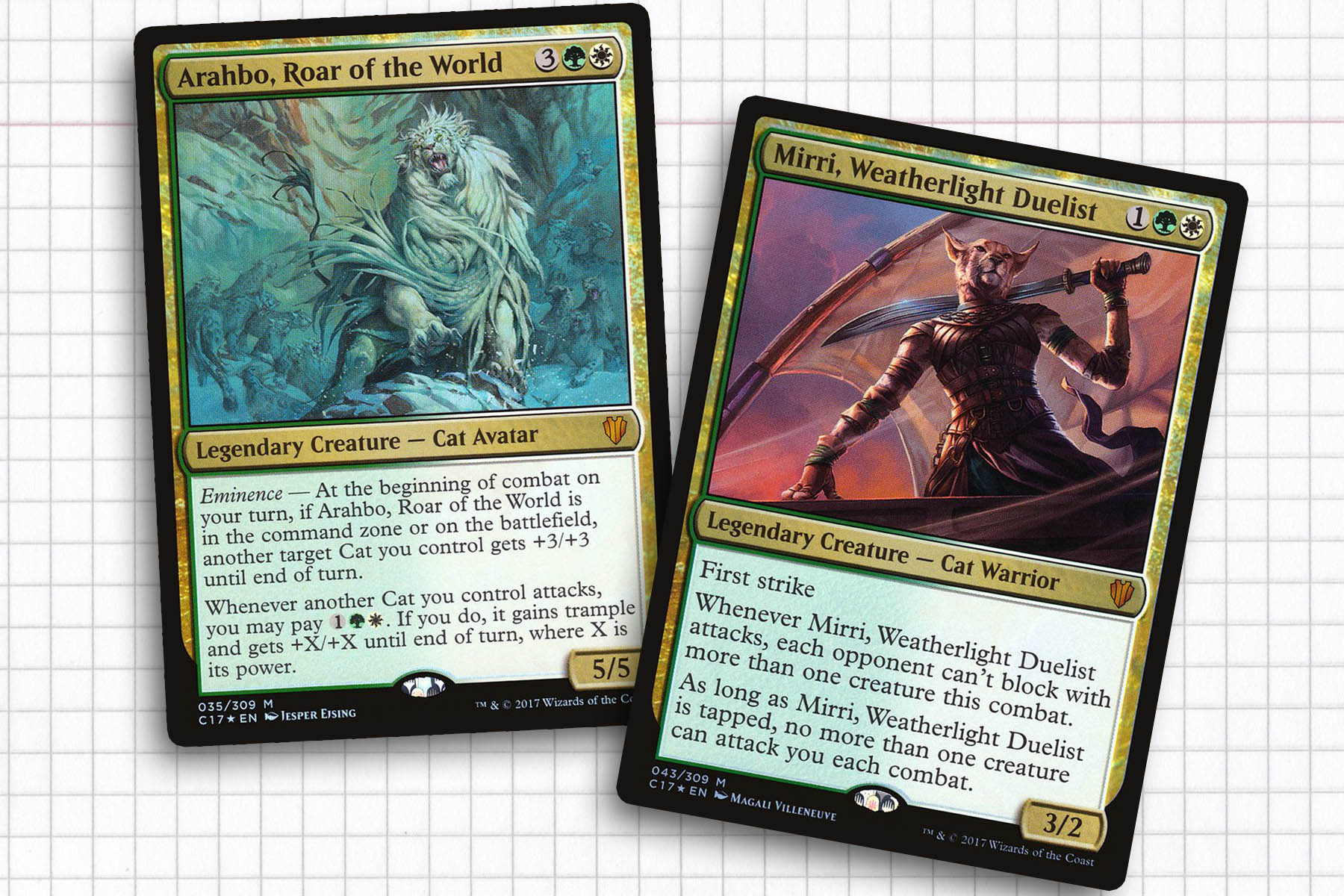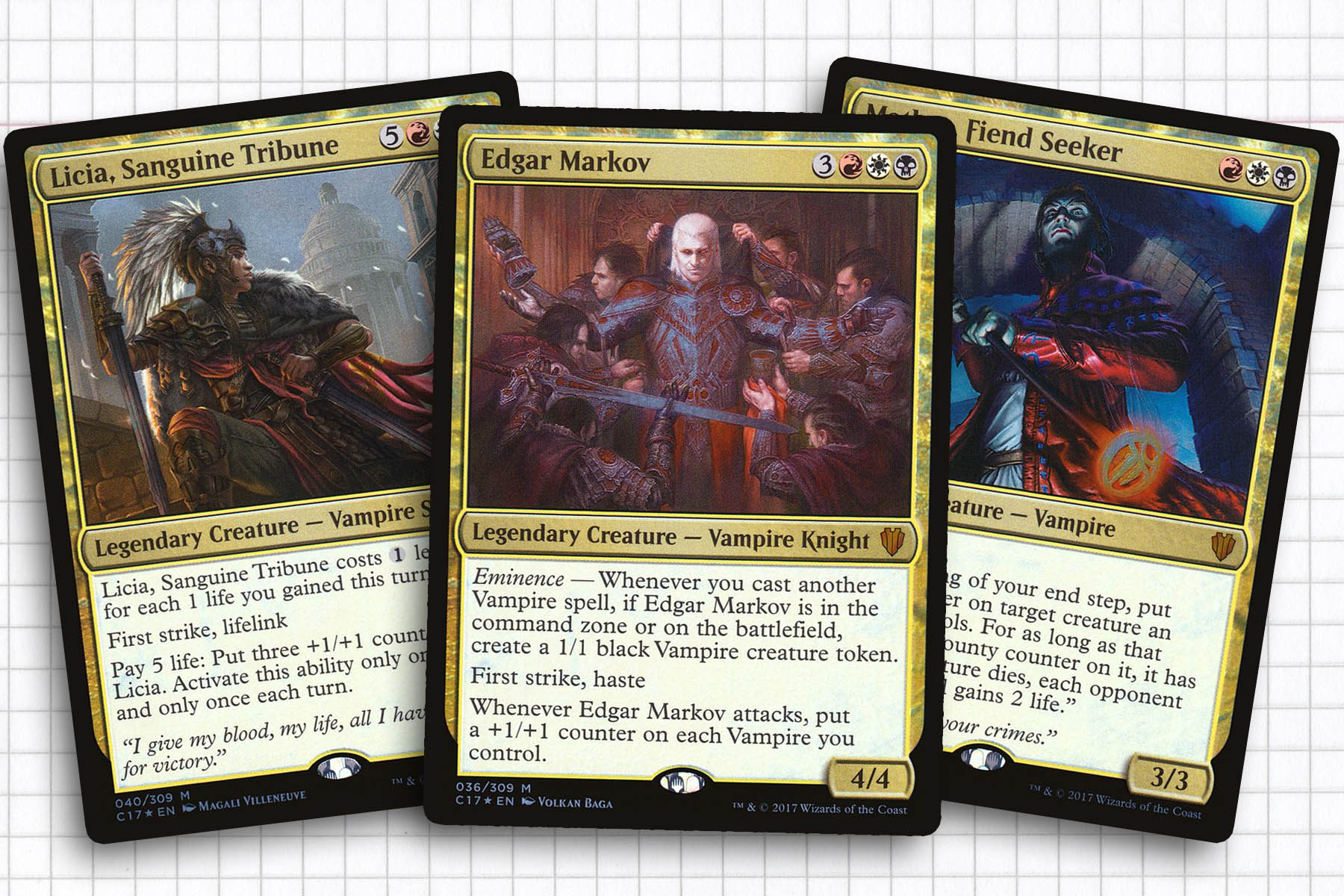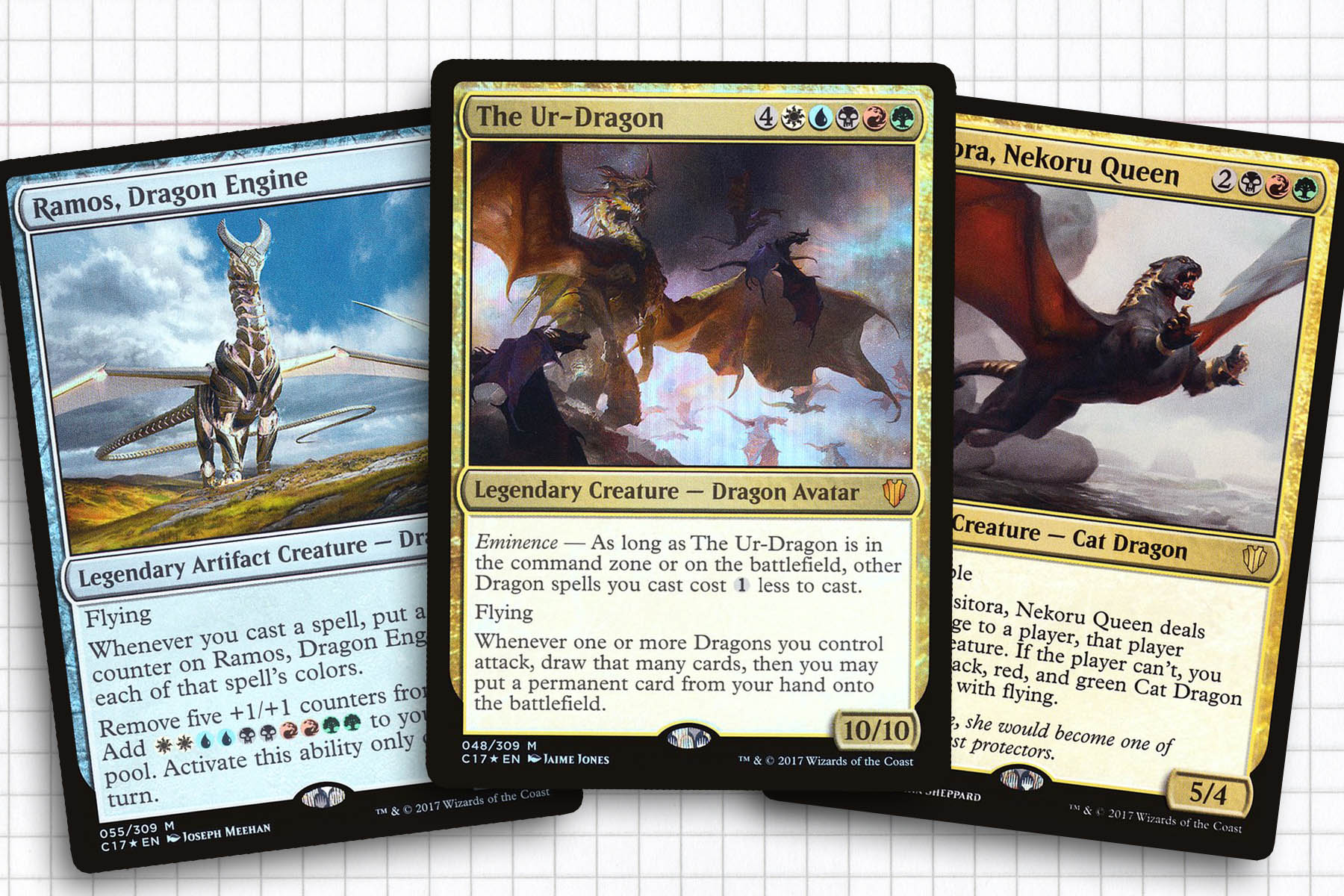Starting in 2011, Wizards of the Coast began producing special Commander sets. The project was certainly ambitious, and the intention from the beginning was to make each collection of decks thematically diverse. More than a decade later, I am revisiting the yearly Commander releases to consider their historical and contemporary performance. Check out my previous examinations: Revisiting Commander 2011, Revisiting Commander 2013, Revisiting Commander 2014, Revisiting Commander 2015, and Revisiting Commander 2016.
Today, I will be looking at Commander 2017 and the impacts its sixteen new generals made on the format. The set holds a special place in my heart: it was the first Commander product to come out during my tenure writing and I feel like it had a lot of really incredible designs. It was the genesis for a handful of decks that I still maintain or had a deep connection to while they were built. I remember really loving the asymmetrical color distribution, the attention it gave to a few underserved tribes, and the resources it granted to that only pre-constructed decks can often supply. This is not to say that there were not some issues to dissect with this product, but overall, it was an immediate personal highlight for the product line.
I will be basing my analysis on the reception these generals received at the time, how they created or supported an archetype, and answer if they maintained any sustained usage. As always, I will be grouping each of the new commanders into the decks they premiered in. Finally, we’ll give my modern thoughts on Eminence, now with almost five years to reflect on it.

Feline Ferocity
Right off the bat, we have the cat tribal deck. It always felt like the most out-of-left-field choice, but I think it really proved to be a correct call. Arahbo, Roar of the World is very popular within the Selesnya color identity, currently sitting as the second most popular. This is, of course, helped by the fact that Arahbo all but legitimized the cat tribal archetype.
Before this set, the tribe was confined to being a mono-white deck with Kemba, Kha Regent or Brimaz, King of Oreskos; if memory serves, the decks being built were not half bad in that state. What I can definitely appreciate about Arahbo is that their eminence ability is useful, but does not create an unreasonable pull on the direction of the game. Additionally, they have a second ability that is very useful, but only able to be activated if they are in play. The tribe has moved on some, with Rin and Seri, Inseparable being the top general for the tribe and I expect that Jetmir, Nexus of Revels will have a substantial percentage of his decks playing in the cat tribal space pretty quickly.
Mirri, Weatherlight Duelist is not a card that I am inclined to speak lightly of. While I would be hesitant to point to any particular archetype that she leads, she has always had a reasonably strong following and is the kind of card that I commonly find myself wanting as a piece of the other 99. Mirri fills a niche role, directing combat so concretely, and her “Dueling Grounds as a legendary creature” design could be the inspiration for more artifact/enchantment turned legends designs in the future.
Commander 2017 is guilty of creating a lot of interesting legendary creatures that were unfortunately overshadowed by legendary creatures within their own deck. I think Balan, Wandering Knight and Nazahn, Revered Bladesmith both fall prey to this. Released at a different time, both of these equipment-focused generals would have had their moments to shine. Balan has the right template to be a solid monocolored Voltron commander, taking the template drawn up for Kemba, Kha Regent and deciding to go tall instead of wide. The gimmick around Nazahn and Hammer of Nazahn is also very compelling, making the template for an equipment minded deck that will often circumvent equip costs. Additionally, I’d forgotten about Nazahn’s second ability, which really speaks to how overlooked they have been, despite having a stellar design.

Vampiric Bloodlust
I have had a troubled history with Edgar Markov, a card I believe may be a mistake that didn’t need to be one. The idea of establishing a bridge between the Innistrad and Ixalan vampires was certainly a valiant effort, but being able to create vampire tokens without ever casting your general from turn one forward was too potent. Edgar currently places at 4th overall in the entire format, and his popularity is a double-edged sword for me. I was happy to see the tribe expand out of monoblack and Rakdos, but too quickly it became clear that Edgar was the de facto vampire general due to his eminence ability. This has gotten to the point where coming to the table with any other vampire general was immediately met with, “why didn’t you just add white for Edgar Markov?”
Edgar’s status amongst the tribe has not changed, but my opinion on his de facto status has lightened up some over the years. As with any other archetype, players are going to gravitate towards the most powerful version of a deck, so something akin to Edgar was bound to exist eventually. It does stand to reason that with Streets of New Capenna, one of the Maestro-aligned vampires, Lord Xander, the Collector, Cormela, Glamour Thief, or Evelyn, the Covetous, may prove to splinter the tribe off some and allow the archetype to at least have two different flavors to it.
Vampiric Bloodlust was yet-again another example of the marquee general overshadowing the remaining legendary creatures in the deck; but when you’re competing with Edgar, that shouldn’t be surprising. I really like Licia, Sanguine Tribune’s design. They push a deck in a direction, but not to such a degree the deck builds itself. In a world with Shadowspear, Mask of Griselbrand, and Heliod, Sun-Crowned, I have to wonder if the card pool has evolved enough for the makings of a solid Licia build to exist.
I remember thinking that Mathas, Fiend Seeker was going to be the perfect overlap of Group Hug and “Group Slug” decks, benefiting off creatures dying by spreading card advantage to the rest of the table. This was an incorrect prediction and Mathas has remained an underrepresented general for their entire tenure. In the end, I’m sad to say that neither of these two have made a noticeable impact as either tribal generals or any niche within their own themes.

Draconic Domination
Draconic Domination is by far my favorite deck of the year. The praise is generated almost entirely by The Ur-Dragon, who is the seventh most popular general in the format and second most popular five-color general. I am guilty of taking the eminence ability for granted and placing more importance on the possibilities the second ability creates. What I have discovered in the intervening years is that most players don’t take the time to cast their Ur-Dragon and instead just win the game off of dragons like Utvara Hellkite and Scourge of Valkas.
Dragons are one of the most popular tribes within Magic, so it is good that we have a marquee general for the tribe that is so universally loved. I think they were pushed in all the right places and they gave a solid option to take a tribe that was already very well established. I even know players that still play with Scion of the Ur-Dragon, because they would prefer to play dragons in more of a combo style. Quite frankly, I am happy to hear that the tribe has maintained a level of diversity that I think such a rich tribe is completely capable of.
O-Kagachi, Vengeful Kami was always going to be a flavor-first general for me and it would seem that the same mentality was adopted by the community as well. I’m not sure what a successful version of O-Kagachi was ultimately going to look like, but this design has always been a little too slow to be a deterrent against players attacking you. Ramos, Dragon Engine, on the other hand, has proven to be a fairly beloved good stuff or combo deck. As the twelfth most popular five color general, Ramos has a unique flavor to their decks, since they want you to play spells with as many different mana symbols as you can. And if nothing else, Ramos will always be a home for Door to Nothingness.
Finally, we have Taigam, Ojutai Master and Wasitora, Nekoru Queen, who were never meant to lead the deck, but serve as flavorful additions within the dragon strategy. These two definitely fall under the overshadowed category, with Taigam being a fine enough role player in spellslinger decks, but seemingly never being the right legend to put in charge. Wasitora is the kind of deep cut that I appreciate being put into the game and I really think a creative budget deck is very possible, but very similar to O-Kagachi, a strategy never really surfaced in any meaningful way.

Arcane Wizardry
Our final deck of the week is probably my least favorite upon arrival and has birthed two decks that I love to play with or against. Inalla, Archmage Ritualist is a fine enough card that was overshadowed by another legend within the deck and for reasons we will get into momentarily. Sitting at seventh overall in Esper and the top wizard tribal general, Inalla proved how different eminence is when it has a mana cost attached to it. Granted, making a copy of a unique creature is very different from the same vampire token over and over, but it proved to be a hindrance that slowed the deck down enough that it has never felt like a pillar of the format.
Then we have Kess, Dissident Mage, a heck of a card that deserves all the attention it gets and the top dog of Grixis commanders. Without explicitly granting flashback to one of your instant or sorcery spells in the graveyard, Kess filled a niche that I think a lot of players were looking for. Flashback is not really a traceable archetype, but Kess’s flavor of spellslinging is certainly powerful and stood the test of time. A deck I know I will lose to, but it will be fun to watch happen.
Mairsil, the Pretender is admittedly a pet card of mine and the closest thing to a combo deck that fits my tastes. Mairsil never really caught on past the initial wave he hit the format with, but he has always been on my mind as I make semi-annual reviews of the new cards each year, looking for discard, blink, or activated abilities that might be perfect for inclusion. Easily my favorite general to come out of Commander 2017 and something I’m so happy exists in the format.
Our final new general of the product is Taigam, Sidisi’s Hand, of whom I have mixed feelings about. On one hand, Taigam is a viable option for a very budget card advantage deck, but has never felt like a card that had a home in anything besides Tasigur, the Golden Fang or Lazav, the Multifarious. This series has shone a light on countless generals printed in these products that never caught on and I’m a little sad to say, Taigam, Sidisi’s Hand was one of those cards.
A Mechanic of High Station
My biggest negative with this product was the creation of the Eminence mechanic. With time, my emotions about it have lessened, and I now believe that tribal may have just been too low of a bar to clear for what some of these generals were capable of. The appearance on Edgar made it rather obnoxious, but the use on The Ur-Dragon was commendable. It helped to take a tribe that is historically more expensive in terms of mana value and recontextualize them to be a little bit faster. In a different world I could have seen the Ur-Dragon mistakenly working more like Kentaro, the Smiling Cat and removing the need for any kind of mana requirements, but luckily that was not the case.
Eminence working in the command zone may have been the one strike against the mechanic that has always remained a sticking point for me. When it is a benefit to your tribe that cannot easily be interacted with by the rest of the table and in the case of Edgar, does not cost you mana, it becomes something that leaves a reasonably sour taste in the mouths of the player base. Even with that said, it is a mechanic that I would love to see come back, but with a little better fine tuning when it comes to what the generals it’s stapled to are capable of.
Overall, I think this was a very well-received product that spawned several extremely notable decks. It stands out as a high point that I don’t know has been equaled since and I feel that some of that comes down to the choice of tribes in this expansion and the direction the product would take in the coming years. There are still great things to say, especially about 2018 and 2019, and I hope to get all of that covered real soon. Thanks for reading.
Ryan Sainio is a Graphic Designer who writes about EDH and the EDH community. He has been playing Magic: the Gathering since 7th Edition in 2002 and values flavorful and fun gameplay over competitively optimized decks.

